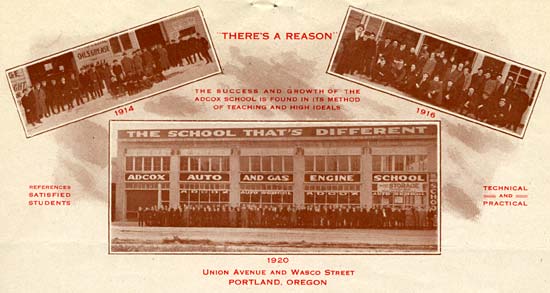 This letterhead shows the growth in class size of Adcox Auto and Gas Engine School in Portland from 1916 to 1920. Much of the growth resulted from a new state law to help veterans. The school enrolled 311 students who received state financial aid for returning soldiers, sailors, and marines. (OSA, Oregon Defense Council Records, State Historian's Correspondence, Box 1, Folder 46)
This letterhead shows the growth in class size of Adcox Auto and Gas Engine School in Portland from 1916 to 1920. Much of the growth resulted from a new state law to help veterans. The school enrolled 311 students who received state financial aid for returning soldiers, sailors, and marines. (OSA, Oregon Defense Council Records, State Historian's Correspondence, Box 1, Folder 46)
The Soldiers' and Sailor's Commission played a key role in aiding those returning to civilian life from the armed forces in the wake of World War I, but other state programs also contributed. Two significant examples resulted from bills passed by the Oregon Legislature, which provided educational financial aid as well as bonuses or loans to an increasingly vocal constituency.
Schools Demobilize
With the end of the war, college campuses quickly made plans for returning to normal life. Just days after the signing of the Armistice, officials proclaimed, "by Christmas the Oregon Agricultural College will be back on an independent basis...." While military training would continue, it would be "of the usual type prevailing in land-grant colleges before the war."
Certainly, college officials must have been happy to reclaim their campuses after the military camp experience. But Oregonians returning from service in World War I would soon invade college campuses in another way. Early in 1919 the Oregon Legislature passed a measure "to provide state financial aid to honorably discharged soldiers, sailors, and marines enlisted or inducted into the service from the state of Oregon, who desire to pursue a course of study in any institution of learning in the state of Oregon, whether public or private." Many veterans applied the funds to enrollment in high school.
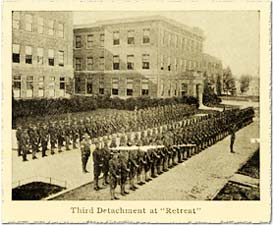 SATC students still in the program at the end of the war did not qualify for the state education aid. (OSA, Oregon Defense Council Records, Publications and Ephemera, Box 8, Folder 4, OAC Bulletin 296)
SATC students still in the program at the end of the war did not qualify for the state education aid. (OSA, Oregon Defense Council Records, Publications and Ephemera, Box 8, Folder 4, OAC Bulletin 296)
The law provided up to $200 per year and $800 total for four years. It could be used for "lodging, board, and other necessities." In order to prevent any unauthorized expenditures, students did not receive the money directly in a lump sum. Instead, it went to the college, which used the "usual forms and restrictions for paying out State funds." The money generally was delivered at $25 per month for eight months of the year. Unfortunately for many Oregon students, the measure also denied financial aid to members of Student Army Training Corps (SATC) who were still in college when the war ended.
By wide margins, Oregon voters twice approved revenue bills to fund the program. And, by January 1920 veterans had filed about 3,000 applications with more expected. According to Governor Ben Olcott, "our financial education aid act has brought inquiries to us from every state in the Union, from those who would re-enact it into law elsewhere."
The Cash Bonus Debate
As the soldiers began to return in late 1918, debate accelerated nationally about providing cash bonuses for veterans of the war. But by January 1921, as another session of the Oregon Legislature was beginning, Governor Olcott had seen enough: "Congress has delayed and haggled over this measure until the light of hope is fast fading." He argued, "Oregon should come forward" to "do something for these men."
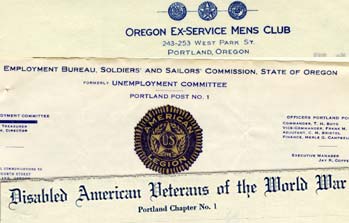 In addition to the American Legion, several organizations developed to advocate for veterans after World War I. (OSA, Soldiers' and Sailors' Commission Records, Case Files, Box 1)
In addition to the American Legion, several organizations developed to advocate for veterans after World War I. (OSA, Soldiers' and Sailors' Commission Records, Case Files, Box 1)
At the same time, veterans organized into an effective voice in Oregon to demand the bonus. On Jan. 13, 1921, about 1,500 veterans gathered at the Portland Armory after the American Legion called a meeting. The boisterous crowd roared its approval for a resolution calling on the Oregon Legislature to allow veterans the choice of $25 for each month of military service or a $3,000 home or farm loan. While the loan portion also won approval, the crowd saved its most "vociferous" applause for the cash bonus.
At the event, the decidedly unpopular "committee of ten," a group of veterans opposed to the bonus, countered that "the disabled veteran is the man that needs the help. It is neither you nor I. He is the man." But "torrents of disapproval drowned all arguments against the cash bonus plan." Supporters of the plan said "that ex-service men are out of work, and their families in want, and that neither monuments nor memorials are so badly needed as financial aid and employment."
Over 90 other American Legion posts in Oregon also supported the bonuses and demonstrations followed to put pressure on the Legislature. The Portland meeting ended with a "bonus parade" marching through the downtown streets of the city. Organizers called on all veterans, Red Cross nurses, and members of the War Camp Community Service to join the demonstration, "in uniform if possible."
The State Responds
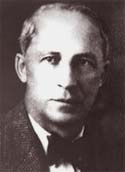 Governor Ben Olcott promoted the work of commission.
Governor Ben Olcott promoted the work of commission.
The governor couched the debate in terms more palatable to fiscal conservatives: "I would not call it a 'bonus.' It would not be a bonus. It would be a very small share of their rightful due, particularly when compared with some of the wages paid to men who worked at home while these men were fighting abroad." Olcott agreed with the American Legion in favoring a payment of $25 for each month of service. He placed his faith in the voters of the state, recommending that the Legislature refer the measure to a special election.
After some tinkering, including dropping the amount to $15 per month of service, the Legislature passed a bill that was put to a statewide vote in June 1921. The governor predicted, "the people of the state are sufficiently appreciative of these great services to respond with an enormous majority in favor of such a measure." His powers of prediction held true as the voters approved the referral by a landslide: 88,219 to 37,866.
The measure approved by the voters acknowledged the difficulties facing veterans. It recognized the "heroic sacrifices," the "difficult problem of readjustment," and the "handicaps they face by reason of unequal losses." The new law created the World War Veterans' State Aid Commission to manage the program. Under the terms of the measure, veterans or the relatives of deceased veterans qualified for the aid. They could choose the bonus or the loan but not both. Veterans who already received money under the educational aid plan would be required to repay it in order to receive the bonus. The commission was required to carefully oversee the program to make sure fraud and abuse did not arise.
Managing the Expensive Program
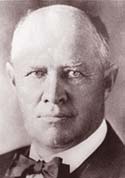 Governor Walter Pierce didn't like the extra taxes levied to run the commission.
Governor Walter Pierce didn't like the extra taxes levied to run the commission.
With millions of taxpayer dollars in play, management of the aid fund drew considerable attention. Governor Olcott admitted the state must be "fully protected by adequately safeguarding the stupendous sums involved." His replacement in the state capitol, Governor Walter Pierce, was blunt in his support of cutting the taxes required to pay for the program, saying in 1923 the "commission should be abolished when money now on hand is expended." But the commission carried on and by 1925 had paid nearly five million dollars in bonuses to veterans. Two years later officials estimated the total amount loaned to veterans for the purchase of homes or farms would total 30 million dollars.
While critics complained about the millions of dollars spent and the higher taxes that resulted, in the end, the Legislature reflected the sentiments of most Oregonians when it stated that "equity, justice and a simple duty" should be recognized for those who "brought us victory and peace."
Notes
(Education: Oregon State Defense Council Records, Publications and Ephemera, Box 8, Folder 4, Oregon Agricultural College Bulletin, Nos. 295, 311; State Historian's Correspondence, Box 1, Folder 16; Oregon Laws, 1919 Ch. 428; Governor's Messages to the Legislature, 1920, page 6; Bonuses: Governor's Messages to the Legislature, 1921-1927; Soldiers' and Sailors' Commission Records, 74 A-3, Correspondence, Box 2, Oregon Journal newspaper clipping; Oregon Blue Book)
Next: Another Try at Isolation >